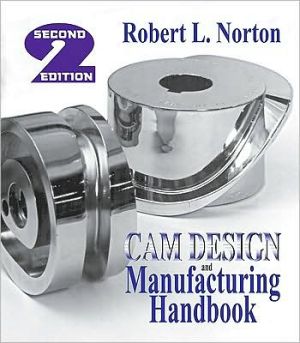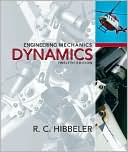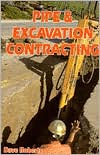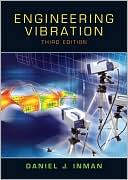Cam Design and Manufacturing Handbook
The use of computers for engineering design, and in numerical control for manufacturing, has dramatically changed the cam design and manufacturing process. Additionally, cam design and manufacturing have been affected by a significant number of fundamental research results published in recent years. An invaluable resource, Cam Design and Manufacturing Handbook brings together up-to-date cam design technology, correct design and manufacturing procedures, and recent cam research results in one...
Search in google:
Includes a completely rewritten and updated chapter on splines, along with a discussion of shape-preserving splines as currently used for automotive valve-train cams. Features added coverage of multi-degree of freedom models and of followers with deliberate impact events within the chapter on dynamic modeling. Covers Globoidal cams in several chapters. Provides a definitive solution to the torque compensation cam design problem. Program Dynacam is much enhanced and improved and is available at a preferred price to purchasers of the book. Booknews Bringing together cam design technology, correct design and manufacturing procedures, and recent research results, this book begins with introductory material and progresses to more advanced topics. It covers the design, modeling, analysis, specification, and manufacture of cam-follower systems. Numerous illustrations are featured. Included is a demonstration copy of Dynacam for Windows 7.0, on CD-ROM. Norton is a mechanical engineer. Annotation c. Book News, Inc., Portland, OR (booknews.com)
Chapter 1Introduction11.0Cam-Follower Systems11.1Fundamentals11.2Terminology41.3Applications91.4Timing Diagrams101.5Cam Design Software101.6Units101.7References16Chapter 2Unacceptable Cam Curves172.0Introduction172.1S V A J Diagrams172.2Double-Dwell Cam Design--Choosing S V A J Functions192.3The Fundamental Law of Cam Design222.4Simple Harmonic Motion (SHM)222.5Constant Acceleration (Parabolic Displacement)252.6Cubic Displacement252.7Summary262.8References26Chapter 3Double-Dwell Cam Curves273.0Introduction273.1Cycloidal Displacement for Double Dwells273.2Combined Functions for Double Dwells303.3The SCCA Family of Double-Dwell Functions413.4Polynomial Functions453.5Fourier Series Functions523.6Summary563.7References56Chapter 4Single-Dwell Cam Curves574.0Introduction574.1Single-Dwell Cam Design--Choosing S V A J Functions574.2Single-Dwell Applications of Polynomials614.3Summary68Chapter 5Spline Functions695.0Introduction695.1Classical Splines705.2General Polynomial Splines815.3B-splines865.4Bezier Curves975.5Knot Placement1055.6Periodic Splines1155.7Splines Other Than Polynomial Splines1195.8Summary1235.9Bibliography124Chapter 6Critical Path Motion (CPM) Cam Curves1276.0Introduction1276.1Constant Velocity Motion1276.2Combined Displacement and Velocity Constraints1396.3Summary150Chapter 7Cam Size Determination1517.0Introduction1517.1Pressure Angle--Radial Cam with Translating Roller Follower1527.2Pressure Angle--Barrel Cam With Translating Roller Follower1577.3Pressure Angle--Barrel Cam With Oscillating Roller Follower1597.4Overturning Moment--Radial Cam With Translating Flat-Faced Follower1617.5Pressure Angle--Radial Cam With Oscillating Roller Follower1627.6Radius of Curvature--Radial Cam With Translating Roller Follower1657.7Radius of Curvature--Radial Cam With Translating Flat-Faced Follower1697.8Radius of Curvature--Barrel Cam With Translating Roller Follower1737.9Radius of Curvature--Barrel Cam With Oscillating Roller Follower1737.10Radius of Curvature--Radial Cam With Oscillating Roller Follower1747.11Radius of Curvature--Radial Cam With Oscillating Flat-Faced Follower1747.12References176Chapter 8Dynamics of Cam Systems--Modeling Fundamentals1778.0Introduction1778.1Newton's Laws of Motion1778.2Dynamic Models1788.3Mass1788.4Mass Moment and Center of Gravity1798.5Mass Moment of Inertia (Second Moment of Mass)1818.6Parallel Axis Theorem (Transfer Theorem)1828.7Radius of Gyration1838.8Modeling Rotating Links1848.9Lumped Parameter Dynamic Models1858.10Equivalent Systems1888.11Modeling Nonlinear Springs1978.12Modeling an Industrial Cam-Follower System2068.13References212Chapter 9Dynamics of Cam Systems--Force, Torque, Vibration2139.0Introduction2139.1Dynamic Force Analysis of the Force-Closed Cam-Follower2139.2Resonance2249.3Estimating Damping2279.4Kinetostatic Force Analysis of the Force-Closed Cam-Follower2339.5Kinetostatic Force Analysis of the Form-Closed Cam-Follower2389.6Kinetostatic Camshaft Torque2419.7Controlling Cam Speed--Motors2469.8Controlling Cam Speed--Flywheels2519.9Torque Compensation Cams2589.10References262Chapter 10Modeling Cam-Follower Systems26310.0Introduction26310.1Degrees of Freedom26410.2Single-Mass SDOF Linear Dynamic Models26510.3Two-Mass, One- or Two-DOF, Nonlinear Dynamic Model of a Valve Train26910.4Multi-DOF Dynamic Model of a Valve Train27210.5One-Mass Model of an Industrial Cam-Follower System27310.6Two-Mass Model of an Industrial Cam-Follower System27910.7Solving System Differential Equations28210.8Polydyne Cam Functions29110.9Splinedyne Cam Functions30710.10References312Chapter 11Residual Vibrations in Cam-Follower Systems31511.0Introduction31511.1Residual Vibration31511.2Residual Vibration of Double-Dwell Functions31611.3Double-Dwell Functions for Low Residual Vibration31911.4References333Chapter 12Failure of Cam Systems--Stress, Wear, Corrosion33512.0Introduction33512.1Surface Geometry33712.2Mating Surfaces33812.3Adhesive Wear34012.4Abrasive Wear34212.5Corrosion Wear34212.6Stress34512.7Strain34712.8Principal Stresses34712.9Plane Stress and Plane Strain35012.10Applied Versus Principal Stresses35112.11Surface Fatigue35212.12Spherical Contact35412.13Cylindrical Contact35812.14General Contact36312.15Dynamic Contact Stresses36812.16Surface Fatigue Failure Models--Dynamic Contact37612.17Surface Fatigue Strength37912.18Roller Followers38612.19Failure of Rolling-Element bearings38712.20Selection of Rolling-Element Bearings38812.21References391Chapter 13Cam Profile Determination39313.0Introduction39313.1Radial Cams With Roller Followers39513.2Radial Cams With Flat-Faced Followers40213.3Barrel Cams With Roller Followers40713.4Linear Cams With Roller Followers41213.5Conjugate Cams41313.6Cam-Linkage Combinations41913.7Shifting the Cam Contour to Machine Zero42113.8References422Chapter 14Cam Materials and Manufacturing42314.0Introduction42314.1Cam Materials42414.2Hardness42814.3Heat Treatment42914.4Cam Manufacturing Methods43214.5Cutting the Cam44014.6Manufacturing Methods44714.7Surface Coatings44814.8Measuring the Cam44914.9References44914.10Bibliography450Chapter 15Lubrication of Cam Systems45115.0Introduction45115.1Lubricants45315.2Viscosity45415.3Types of Lubrication45515.4Material Combinations in Cam-Follower Joints46015.5Hydrodynamic Lubrication Theory46115.6Nonconforming Contacts46515.7Cam Lubrication47215.8References473Chapter 16Measuring Cam-Follower Performance47516.0Introduction47516.1Transducers47516.2Experimental Cam-Follower Measurements48316.3Data Analysis48416.4References49816.5Bibliography498Chapter 17Case Studies49917.0Introduction49917.1Analyzing Vibrations in an IC Engine Valve Train49917.2Analyzing Vibrations in Cam-Driven Automated Assembly Machinery51117.3References520Chapter 18Cam Design Guidelines52118.0Introduction52118.1Practical Design Considerations52118.2Rules of Thumb for Cam Design53018.3References532Appendix AComputer Programs533A.0Introduction533A.1General information533A.2General Program Operation534A.3Program Dynacam541A.4Program Fourbar554A.5Program Sixbar562A.6Program Slider565Appendix BMaterial Properties569Appendix CGeometric Properties573Appendix DSpring Data575Bibliography579Glossary of Terms599Index601Index to CD-ROM609Installation Instructions for CD-ROM610
\ Bringing together cam design technology, correct design and manufacturing procedures, and recent research results, this book begins with introductory material and progresses to more advanced topics. It covers the design, modeling, analysis, specification, and manufacture of cam-follower systems. Numerous illustrations are featured. Included is a demonstration copy of Dynacam for Windows 7.0, on CD-ROM. Norton is a mechanical engineer. Annotation c. Book News, Inc., Portland, OR (booknews.com)\ \








